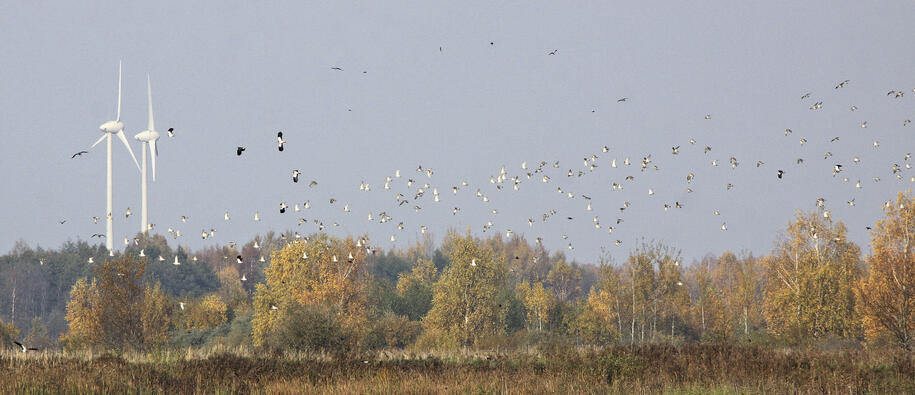Currently available funding
There are currently no calls for proposal.
Programme Summary
Why was the programme needed? Lithuania hosts a great diversity of species and natural habitats. Natural and semi-natural ecosystems occupy more than one third of the country, while protected areas of different types (national and regional parks, nature reserves) cover more than 15% of the of the national territory. However, heavy industrialisation and extensive development of agriculture have caused considerable harm to the environment, particularly to biodiversity and ecosystems. Large-scale land drainage schemes implemented in 1960-1980s have destroyed up to 70% of the country’s wetlands. Moreover, open habitats such semi-natural meadows and pastures, which serves as nesting grounds for bird species were either transformed into arable lands or abandoned altogether. As a result, the habitats were gradually overgrown by low-value shrubs, preventing bird species from nesting. Coupled with climate change-triggered changes to the environment, these developments have led to serious degradation of Lithuania’s biodiversity and ecosystems. The Lithuanian Biodiversity and Ecosystem Services programme, with a funding of almost 7 000 000 euros from the EEA Grants, aimed to rehabilitate and restore ecosystems in various regions of the country, as well as to improve the management of important protected areas. The programme was implemented by the Lithuanian Ministry of Environment. The Ministry of Environment, as programme operator (PO), was assisted a Donor Programme Partner (DPP) - the Norwegian Environment Agency (Miljødirektoratet – NEA). The funding was the EEA Grants was a welcomed addition to the EU Structural and Investment Funds, since environmental protection is a costly undertaking and usually requires government agencies to prioritise needs and measures. What did the programme achieve? Altogether, 13 projects were implemented. The status of natural environment very much depends on stability of ecosystems. The more diverse an ecosystem is the healthier it is and various species, including those of EU importance, have better conditions to thrive. Several of the altogether 13 projects implemented under the programme focused on developing a methodological basis for data collection required to assess the status of species of EU importance and their respective habitats, as well as various impact factors. Together, these projects covered around 100 species of community importance and developed methodologies for each one of them. In addition, nearly 300 management plans for Natura 2000 areas were developed and/or expanded upon. These management plans have become tools for the directorates of protected areas and may serve as a basis for developing new project proposals. Another important set of activities implemented under the programme centered on wetland restoration and management of open habitats. The Varniai National Park implemented a major project on restoration of the Biržulis-Stervas wetland, while the Žemaitija National park demonstrated sustainable ways for composting excessive biomass from the eutrophicated lake. Three projects aimed at management of open habitats through the involvement of local communities by means of both innovative and sustainable cattle breeding; freely roaming cattle or sheep prevent the open habitats from overgrowing, while participating farmers benefit from meat and wool sales. These projects were implemented in the sparsely populated areas of the Gražutė, Sartai and Kurtuvėnai regional parks, the Nemunas Delta Regional Park and in the Dzūkija National Park. A third group of activities sought to develop means for ecological education, which turned out to be very popular among the directorates of protected areas. The Protected Areas service, building on Norwegian know-how, developed curricula for nature schools and acquired equipment to be used during tuition process. A groups of young students (junior, junior high schools) are offered courses which may last from one to several days, both indoors and outdoors. Depending on the time of the year, the park rangers introduce children to natural phenomena, and demonstrate and teach the students to recognise various plant and animal species in their natural environment. The site-specific curricula is currently used by 31 directorates of protected areas (prior to the programme only three directorates used such curricula). How were bilateral relations strengthened? A distinctive feature of the EEA and Norway Grants mechanisms was the promotion of bilateral cooperation and exchanges between Lithuanian governmental agencies and NGO experts with their colleagues and counterparts in Nordic countries, primarily in Norway and Iceland. Quite a few Lithuanian environmentalists from the protected area directorates, academia and NGOs took advantage of this opportunity and participated in study tours to Norway and Iceland. Additionally, a number of seminars and workshops took place in Lithuania, e.g. the Natura 2000 Biogeographical Process on the Boreal Region Seminar held in Vilnius in October 2016 and attended by over 80 participants from 10 countries and the bilateral Lithuanian-Norwegian ornithological seminar on identification of lesser white-fronted geese in April 2017. The programme contributed to promotion of new approaches in biodiversity management and fostered bilateral Lithuanian-Nordic cooperation in the field of environmental protection. For one of the projects focused on wind power and its ecosystem impacts, bilateral cooperation was particularly important. The Lithuanian Nature Research Centre cooperated closely with the Norwegian Institute for Nature Research (NINA) and the Norwegian partner shared its experience in area of sustainable development of overhead powers lines, submitted information about different practices of wind power development in other countries, and supported the Nature Research Centre on creating a Wind Power Conflict Zoning Tool. What will be the impact of the programme? Many of the activities implemented in the Lithuanian biodiversity programme are sustainable and with long-lasting results, especially those focused on restoration of wetlands and managing open habitats. These projects will continue well beyond the closing date of the programme. The Water Sector Development Action Plan for years 2017-2023 foresees activities contributing to gradual wetland restoration nation-wide which will have positive effect both on biodiversity protection and climate change adaptation. Similarly, the databases on species and habitats created under the programme, as well as the thematic maps identifying sensitive areas for wind farm development, will serve as an indispensable tool both for planning and decision-making purposes for years to come.
